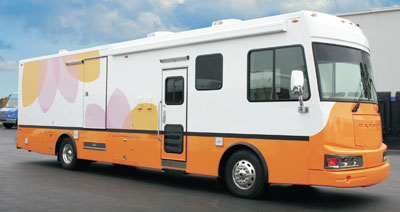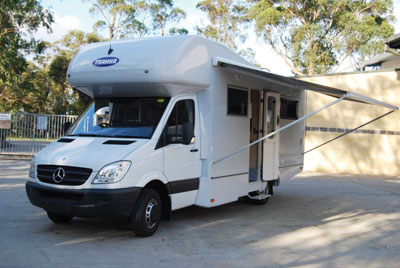
Although neither new, nor revolutionary, the concept of having your
chiropractic clinic on wheels – and you travelling, perhaps not to
patients’ homes, but to their locale of choice – is a business model
that, for some, could work well.
Although neither new, nor revolutionary, the concept of having your chiropractic clinic on wheels – and you travelling, perhaps not to patients’ homes, but to their locale of choice – is a business model that, for some, could work well. Many areas, particularly smaller communities, cannot support a full-time chiropractor yet require the services chiropractors provide. In the rural areas of the United States and Europe, and in specific areas of larger cities, for medical, dental and related health-care services, including chiropractic, mobile clinics are quite popular. Yet in Canada, this concept does not seem to have caught on.
 |
|
| A complete chiropractic clinic can be housed in a vehicle specifically built for the purpose. Advertisement
|
The intent would be to have a complete chiropractic clinic housed in a vehicle specifically built for the purpose, from which you would attend to the needs of patients in their locales. Under-serviced populations in rural communities and marginalized areas in larger cities would be attracted by the flexibility that a mobile clinic offers to patients who wish to obtain chiropractic services.
An alternative model
Another idea is to work from a combination of both a mobile and a fixed-base clinic so that the chiropractor can make timely patient consultations and remedial procedures more attainable, while offering a location where more complex procedures can be housed, if they are necessary. The principal patient benefit would be that instead of them always having to come to you, for certain situations, you now can go to them. As well, it is from the fixed base that appointments are scheduled and there that most records are kept. Perhaps this is a concept whose time has come, or that is at least worth consideration.
Although for this article no specific owner of such a practice could be interviewed, an overview of available data suggests that mobile clinics work best when serving rural communities with populations that range from 2,000 to 10,000 on a one- or two-day basis, every two weeks. These same clinics can be used to serve outlying districts of larger cities as well. (In most cases, this type of practice would still require a fixed-operating, or headquarters, base, if for no other reason than to provide a location from which to book appointments and in which to house records. But given the benefits for your patients, extra costs for the mobile component may also be cost effective.
As health-care costs are rising exponentially, creating an almost insurmountable burden for some employers, many are seeking wellness solutions in the workplace. Parking a mobile chiropractic clinic beside a factory eliminates employee travel time and reduces waiting to a minimum. This will benefit the staff and make financial sense for the factory’s management. It’s an idea well worth exploring.
What will you need in a mobile clinic?
Required facilities should include an on-board electric power source with adequate power outlets; space for work and storage; a waiting area; good lighting; efficient heating and air conditioning; an on-board restroom, stabilizing jacks, and features for easy loading and unloading of equipment. You might also add equipment so you can provide a broader range of chiropractic services and a chair lift from the exterior to the interior for persons who would have difficulty climbing the stairs required to enter.
Decor can be important. You are a professional and you want a professional-looking mobile clinic. Patients can be turned off by one that looks like a worn out holiday trailer that was adapted for the purpose.
The vehicle itself
Where the length of the vehicle does not exceed 12 metres (40 feet) a mobile chiropractic clinic is best developed in a van body built on a truck chassis. Lee Guse of Life Line Mobile, a builder of these units, says that his company builds each unit individually to the specifications of the customer. He adds that they use commercial grade construction methods, which has proven to be a far more satisfactory approach than modifying a lighter-weight chassis such as that of a recreational vehicle or a school bus. The heavier chassis is far better and can withstand continual use longer and at a much lower overall maintenance cost. He also advises that depreciation rates vary per age, use and maintenance. After 10 to 12 years of continuous use the residual value would be in the neighbourhood of five to 10 per cent of original cost.

|
|
| Mobile clinic units should be built individually to the specifications of the customer using commercial grade construction methods, rather than by modifying a lighter weight chassis like that of a recreational vehicle or a school bus.
|
There are several manufacturers of vehicles for this express purpose. All will be pleased to supply price estimates, delivery times, finance options and estimated operating costs. A perusal of the Internet will provide names, locations and, often, detailed information.
Although there are used vehicles available and adaptable to chiropractic purposes, the price for a new, fully equipped mobile clinic starts at about $150,000 and shoots upwards from there. You could pay over $300,000 for one that is super-deluxe. This is why, before creating a mobile clinic, it is important to undertake a detailed feasibility study. It’s great to be a missionary, but you are still running a business. You will need to put a lot of patients through to justify the initial outlay and operating cost.
Vehicle licensing is not a major obstacle. Although to be used as a chiropractic clinic there is a difference in vehicle and driver’s licensing requirements from one province to the next. All are governed by the regulations concerning trucks where size, length, width and weight are prime considerations. And, you will be driving a truck. Check with your own province for further jurisdictional requirements and laws.
Will this be worth it for you?
It is important that before making a vehicle purchase and venturing into this field you first commission a cost-benefit study. The investigation program should factor in specific locales to be served, financial projections, staffing needs and required equipment. It should detail the number of people in the geographical area you intend to serve, barriers to providing that service, distances patients must now travel to reach your clinic, the minimum number of patients required to make the project feasible, start-up and operating costs. What services will you provide? What equipment will you need? Which sites will you visit and how often?
Yes, a thorough and professionally done cost-benefit analysis will cost a few dollars. Still, if you have analyzed the situation correctly, it will point out where and how you could effectively, economically and profitably serve a market that requires your services.
Although delivering and receiving chiropractic services from a mobile clinic could provide many benefits for chiropractors and patients, this method of delivering health care is not for everyone. These vehicles cost big bucks and in a limited or restricted market may prove to be a poor investment. Your pre-purchase study should ensure that this investment satisfies your objectives and overcomes your constraints.
Lloyd Manning is a semi-retired business, commercial real estate appraiser and financial analyst. His newest book – Winning With Commercial Real Estate – The Ins and Outs of Making Money In Commercial Properties is available online from Indigo-Chapters. He can be reached at lloydmann@shaw.ca.
Print this page